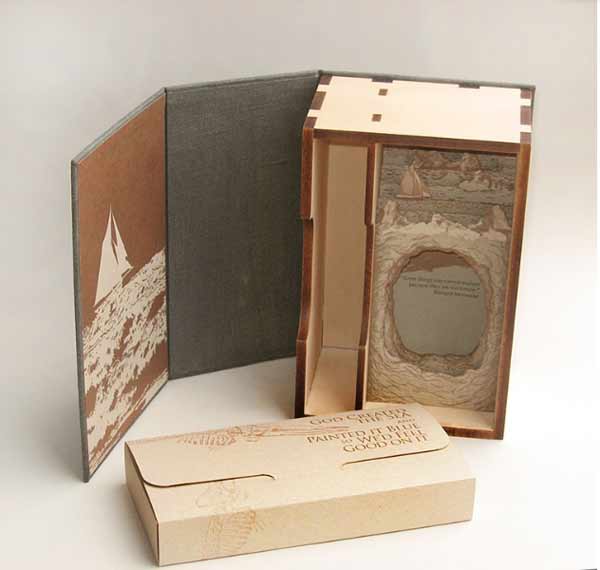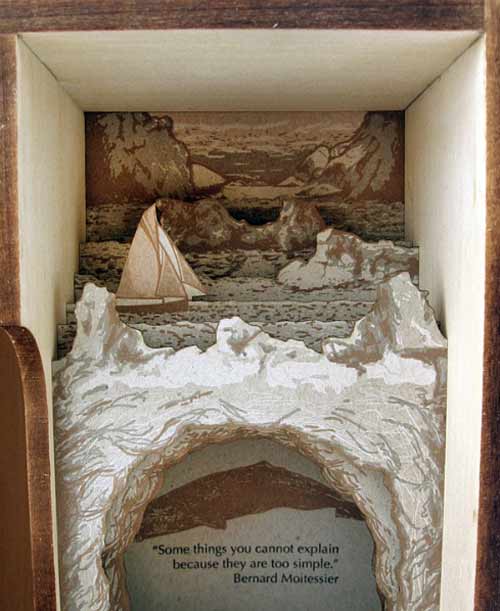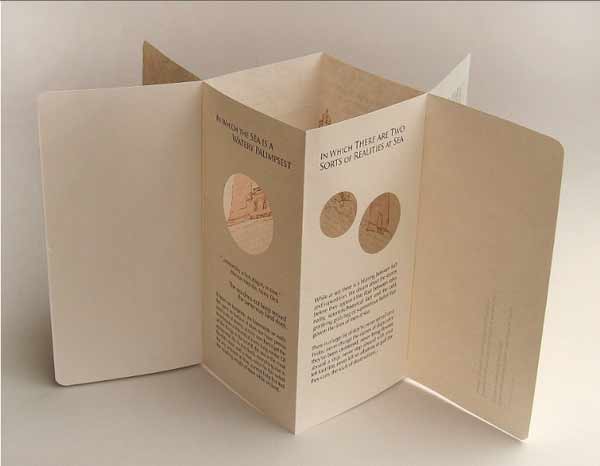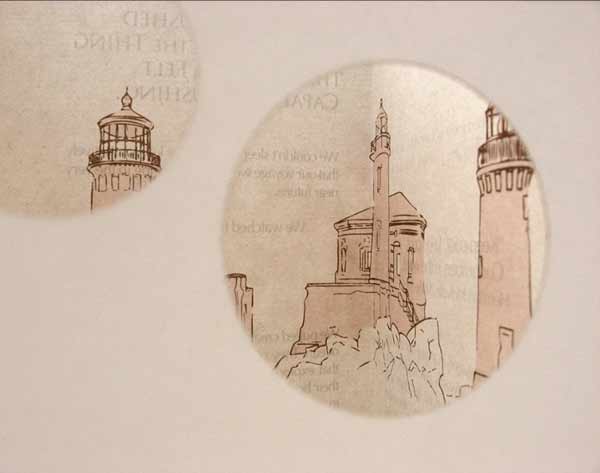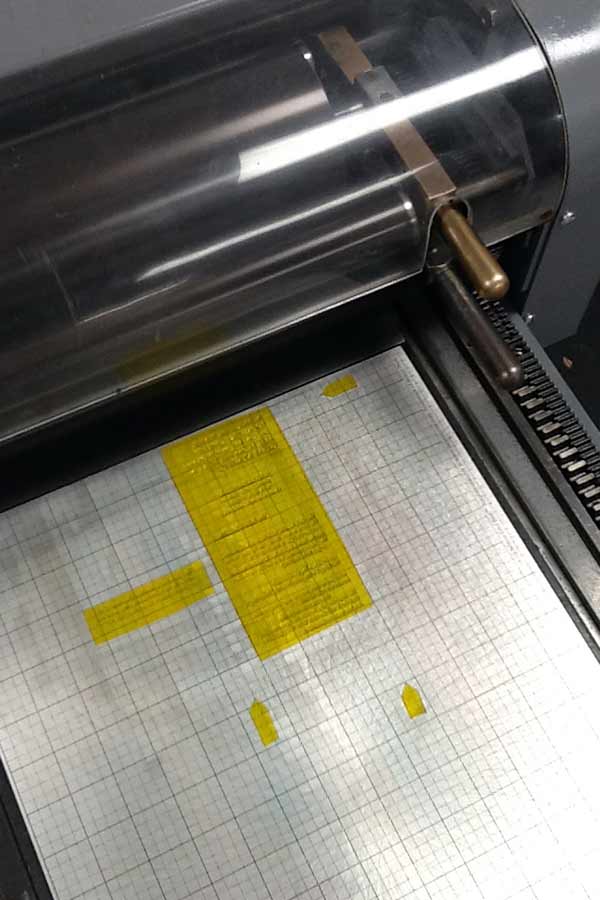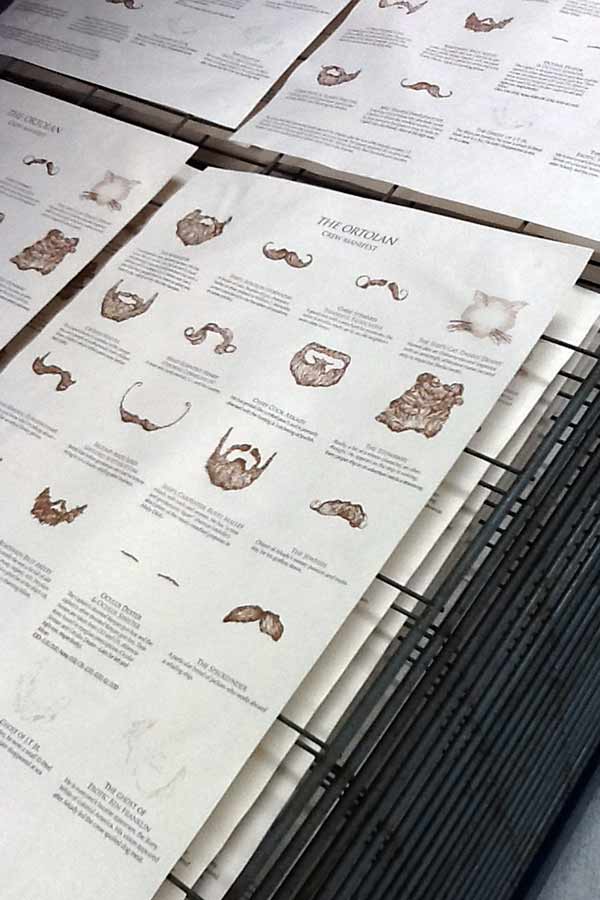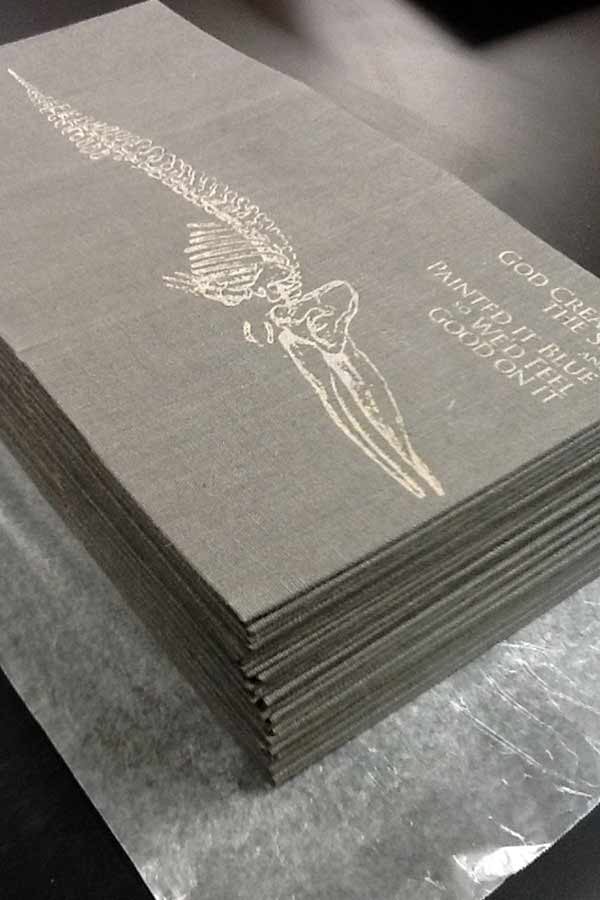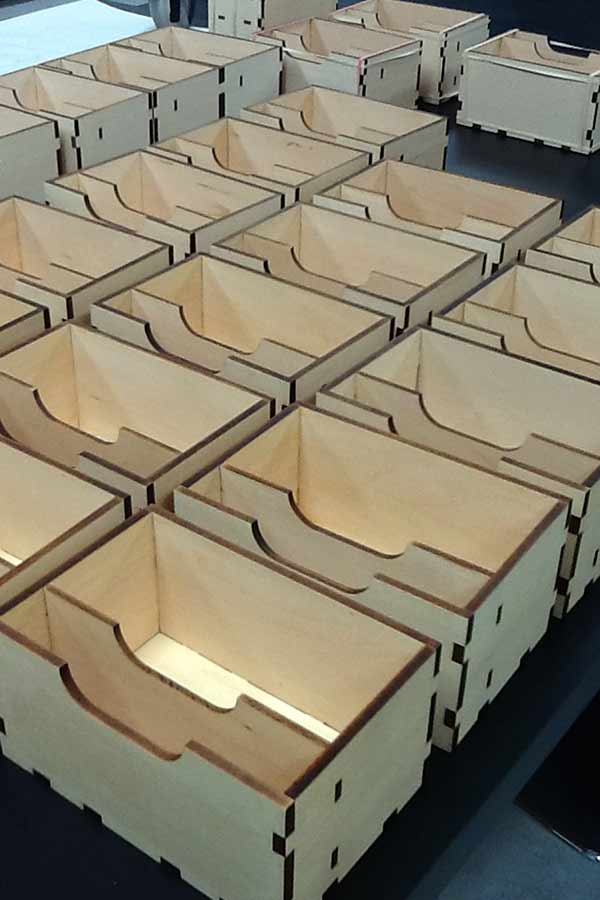As I read the concept behind God Created the Sea and Painted it Blue so We’d Feel Good on it, I am reminded of the Michel Gondry film The Science of Sleep and how we create vessels in the physical world to guide our journeys through our imaginary worlds. In 2013, Michelle Ray used such an experience as the inspiration for her most recent artist book.
Michelle first learned how to use a map while sailing. Out on the sea, where there are no landmarks just an ever-changing landscape.
As Michelle explains: In reference to the sea, this edition’s text states, “There are no markers in this/ monochromatic/ parking lot.” In the absence of these markers, we become painfully aware of their significance. This work is about experience, perception, memory and the space in between composed of symbol, sound and object. This is the space of mediation, the space where significant things happen; it is the ocean on which my imaginary crew and I sailed, the place for which there are no maps.
Imagery and text have been printed using photopolymer plates on handmade cotton/abaca, French Construction and Neenah Environment papers. The photographs that follow were taken to document the printing and binding processes of God Created the Sea.
The enclosure is made of linen and basswood. The linen is printed with the image of a whale skeleton along with the title in gold. This piece was produced in an edition of 50 at the Small Craft Advisory Press as Michelle’s creative project in the MFA Book Arts Program for The University of Alabama.
God Created the Sea is already housed in several collection across the United States and in the United Kingdom. In addition, been awarded Best of Show at the Foundry Art Centre in Missouri and runner-up at The Sheffield International Artist’s Book Exhibition in the UK.
Michelle is the recent recipient of the Artists’ Book Cornucopia IV Gallery Director’s Exhibition Award presented by the Abecedarian Gallery. This announcement is when I first discovered and fell in love with her work. Although, I’ve never had the pleasure of seeing Michelle’s work in person. Her work is clearly crafted beautifully, balancing rich content and concepts with thoughtfully executed structures. Her work will be featured in a solo Reading Room exhibition from April 18 – June 7, 2014 at the Abecedarian Gallery in Denver, Colorado. Oh, how I hope I find myself in Colorado next spring. Read the interview after the jump and come back each Monday during the month of September for more posts on the work of Michelle Ray.
Earlier this year, you received an MFA in the Book Arts program from the University of Alabama. Can you discuss your path into book arts and how your training/experience at UA has influenced your creative process?
I was first introduced to book arts in the late 90s during my undergraduate years at the University of Pittsburgh. My sculpture professor suggested the format after she noticed my interest in assimilating words, form and temporal/kinetic elements in my work (I also had a habit of citing writers, rather than visual artists, when asked about my influences). My work in books took off from there and I did a lot of independent research as well as formal training at places such as the North Bennet Street School (my first workshop) and The University of Alabama (my recent MFA degree). Both NBSS and UA injected a strong sense of technical craft into my process as did my preservation training at The University of Pittsburgh.
Having three years dedicated to making books, as I did in the MFA program at The University of Alabama, afforded me the time I needed to live in the studio and develop my work. I found strong mentorship within the program and the well-equipped facilities allowed me to grow as a book artist by developing solid technical/material outlets for my ideas. As an aside, we had a large tornado destroy the town of Tuscaloosa during my time there in graduate school. The experience shook me to my core and provided some of the more profound lessons from my time there. For me, graduate school and the tornado will always feel like intertwined learning experiences.
Did your fascination with lists, categories and collections spawn from your studies in Information Sciences from the University of Pittsburgh? How do you incorporate this enthusiasm into your work?
Language and organization have always been my mode of synthesizing my transactions with the world. I was drawn to the MLIS library preservation program because of my interest in organization and permanence. I’ve always been a left-brained maker and recall as a child protecting my drawings with layers of clear tape and neatly filing them away in a shoe box! My preservation training at the University of Pittsburgh more deeply instilled a love of materiality in me and gave me a strong grounding in best practices in terms of material choices and process. The theory I learned there lent language and context to ideas I had been concerned with for a long time. While completing my MLIS, I had no idea that the concepts I was exploring would end up translating into my visual work.
Your work explores systems of thought associated with archives, natural history artifacts and rituals of organization. Using language and imagery you navigate between human experiences, perception and memories. How have your own experiences and memories influenced your work? Water and boats reoccur as themes in several of your books.
I grew up on the Little Shenango river in Pennsylvania’s Rust Belt. This river, home to crawfish, broken glass bottles, and offal from the neighbor’s chicken butchering, was the centerpiece of my childhood. I was always in it or on it, wading and fishing and shooting down the miniature rapids in an inner tube or raft made of milk jugs. It was the place where I learned independence and respect and all the other good lessons of a rural childhood. The natural world was an important part of my upbringing and my childhood was filled with poking holes with sticks and borrowing books about edible plants from the local library. Later in life, Annie Dillard’s book, Pilgrim at Tinker Creek, had a profound impact on how I looked at and interacted with the natural world around me.
I’ve been a builder of small sailboats and a lover of “craft” in the many senses of the word. It was a wonderful sort of kismet that brought me to Small Craft Advisory press to create a piece about the sea. For me, being on the water is a perfect, self-contained experience. A boat is as beautiful and pragmatic an object as there is in the world and I respect the interrelatedness of a vessel’s aesthetics and functionality. I value the economy of space that exists in books and boats; both represent self-contained worlds, microcosms. I also love the history and arcane language of sailing. There’s an element of historical reenactment every time I hoist a sail (this impulse is at the root of my love for printing and binding as well!).
Your work integrates many sculptural and interactive elements from pull tabs to tunnel books to the layering of textural prints, creating a more playful and pleasurable experience for the reader. Can you discuss your process for transforming an idea into a physical book?
I aim to push the process of “reading” for the viewer, as I’m sure most book artists do. Words, visual content and structure work together to make a piece and I don’t see a natural hierarchy or order to these elements of the book. My process for developing structure and content is non-linear and evolves differently for each project. Typically, language is the spine of my work; I’ll begin with a sentence or list of words and build from there. For a person with a visual arts background, my notebook is terribly full of words! Once I get a sense of a particular concept, I’ll grab bits of paper and fold and stitch until things begin to make sense. I keep a collection of folded napkins, scraps of paper and assorted packaging as reference material. Images tentatively take up residence on the pages along with text and develop a reciprocal relationship with the structure as a project progresses. I use many different processes and tools including the Adobe suite, pen and ink, laser engravers–you name it, it’s part of my process. My favorite trick is to place my mock-ups on my nightstand at night so that I can look at them with fresh–very fresh–eyes when I wake up in the morning.
Your most recent project was completed in conjunction with a residency at the Small Craft Advisory Press, which is a program affiliated with the Florida State University in Tallahassee. Can you talk about the structure and length of this residency? Did you enter the residency with a proposed project?
This residency is a wonderful opportunity for students in the book arts and I’m deeply appreciative that Denise Bookwalter created and runs it. The residency is a year-long opportunity for third year graduate students to work with the press on their projects and have 24/7 access to the equipment at the Facility for Arts Research (FAR), where the Press is housed. As a resident, I got the chance to work with visiting artists in a number of capacities from brainstorming to production. FAR is a wonderland of equipment, space and helpful staff and its offerings include multiple models of laser engravers, Vandercooks and 3-D printers. I entered the residency experience with a detailed plan for the edition, but once I arrived and began playing with the equipment, I altered my strategy somewhat because of the technical capabilities I had at my disposal.
As a part of the residency, I was given the opportunity to teach an undergraduate course entitled, Structural Book, at Florida State University and I can’t say enough kind things about the quality of students I had in my classes. For me, teaching in a conceptually weighted program was a good change of pace from the process-oriented world I had been living in. And the students enjoyed melding conceptual thinking with fussy historical practices.
What is up next for you? Are you currently working on any new projects?
Currently, I’m in the final production stages for an edition entitled The Cave Protection Act of 2013. This edition is illustrated using Rhino 3-D software and was printed at the Small Craft Advisory Press. The idea for the project came from a documentary I watched about Centralia, Pennsylvania. This mining town was destroyed when an underground fire broke out, creating sinkholes and sucking the town into the earth. I responded to how the town developed a strong identity because of its erasure. This sense of identity from erasure–of absence speaking volumes–struck a nerve since I had been through the 2011 Tuscaloosa tornado and saw how the town was simultaneously put on the map (in terms of media coverage) and wiped off the map (in terms of lost lives and property). For my project, I used copy from the The Federal Cave Protection Act of 1988 as a point of departure and re-wrote it to create an inquiry into absence, domesticity, memory and the vernacular archive or archive of everyday objects. I also just started work on a collaborative piece about the nature of perception and distance. My collaborator, Herman Sample, is constructing objects and sending them to me via mail for my interpretation using 3-D modelling software, pencil and text.
A few more tidbits about Michelle.
I’m employed at the Facility for Arts research (FAR) at Florida State University as the Information Assistant/Writer and I’m exploring the possibility of starting a small fine printing shop here in Tallahassee (I just bought a press so perhaps I’m well beyond the exploratory stage!). In addition to that, I’m continuing on with my studio practice and trying to expand the range of collections that include my work in their holdings. Vamp & Tramp Booksellers and Abecedarian Gallery have been wonderful supporters of my work and have opened many doors in terms of getting my (and many others’) work out into the world.
